Product information “HI83399 Portable COD and Multiparameter Photometer and pH Meter”
HI83399 is a compact, multiparameter photometer for measuring key water and wastewater quality parameters. The meter is one of the most advanced photometers available with a innovative optical design that utilizes a reference detector and focusing lens to eliminate errors from changes in the light source and from imperfections in the glass cuvette. 40 key water and wastewater quality parameters with 73 different methods covering multiple ranges are programmed into the meter. Wastewater treatment digestion parameters include COD, Total Nitrogen and Total Phosphorous which are important for monitoring nutrient removal. The HI83399 also offers an absorbance measurement mode for performance verification and for users that would like to develop their own concentration versus absorbance curves.
To save valuable laboratory benchtop space, the HI83399 doubles as a professional pH meter with its digital pH/temperature electrode input. Now one meter can be used for both photometric and pH measurements.
Advanced optical system
Unparalleled performance from a benchtop photometer
Digital pH electrode input
Save valuable bench space with one meter that works both as a photometer and as a laboratory pH meter
Water and Wastewater Treatment Digestion Parameters
Allows measurement of COD, Total Nitrogen and Total Phosphorus
Details
HI83399 benchtop photometer measures 40 different key water and wastewater quality parameters using 73 different methods that allow for multiple ranges and variations in chemistry for specific applications. The Chemical Oxygen Demand (COD) parameter is included for industrial and municipal wastewater treatment. The Phosphorous and Nitrogen parameters included are beneficial to municipal wastewater treatment customers that need to monitor their biological and chemical nutrient removal process. This photometer features an innovative optical system that uses LEDS, narrow band interference filters, focusing lens and both a silicon photodetector for absorbance measurement and a reference detector to maintain a consistent light source ensures accurate and repeatable photometric readings every time.
A digital pH electrode input is provided allowing the user to measure pH by a traditional glass electrode. The digital pH electrode has a built in microchip within the probe that stores all of the calibration information. Having the calibration information stored in the probe allows for hot swapping of pH electrodes without having to recalibrate. All pH measurements are automatically compensated for temperature variations with a built in thermistor located in the tip of the sensing bulb for fast and accurate temperature measurement.
Two USB ports are provided for transferring data to a flash drive or computer and to use as a power source for the meter. For added convenience and portability the meter can also operate on an internal 3.7 VDC Lithium-polymer rechargeable battery.
The HI83399 offers an absorbance measuring mode that allows for CAL Check standards to be used to validate the performance of the system. The absorbance mode allows the user to select one of the 5 wavelengths of light (420 nm, 466 nm, 525 nm, 575 nm, and 610 nm) to measure and plot their own concentration versus absorbance mode. This is useful for users with their own chemical method and for education to teach the concept of absorbance by using the Beer-Lambert Law.
pH Specifications
pH Range Photometer: 6.5 to 8.5 pH
pH electrode: -2.00 to 16.00 pH
pH Resolution Photometer: 0.1 pH
pH electrode: 0.01 pH
pH Accuracy Photometer: ±0.1 pH
pH electrode: ±0.01 pH
pH Calibration Automatic one or two point calibration with one set of standard buffers available (4.01, 6.86, 7.01, 9.18, 10.01)
pH Temperature Compensation Automatic (-5.0 to 100.0 oC; 23.0 to 212.0 oF); limits reduced based on the pH electrode used
pH CAL Check (electrode diagnostics) clean electrode and check buffer/check probe displayed during calibration
pH Method Photometer: phenol red
pH-mV Range ±1000 mV
pH-mV Resolution 0.1 mV
pH-mV Accuracy ±0.2 mV
Oxygen, Dissolved Specifications
Oxygen, Dissolved Range 0.0 to 10.0 mg/L (as O2)
Oxygen, Dissolved Resolution 0.1 mg/L
Oxygen, Dissolved Accuracy ±0.4 mg/L ±3% of reading
Oxygen, Dissolved Method Adaptation of the Standard Methods for the Examination of Water and Wastewater, 18th edition, Azide modified Winkler method
Absorbance Specifications
Absorbance Range 0.000 to 4.000 Abs
Absorbance Resolution 0.001 Abs
Absorbance Accuracy +/-0.003Abs @ 1.000 Abs
Alkalinity
Alkalinity Range Freshwater: 0 to 500 mg/L (as CaCO3)
Seawater: 0 to 300 mg/L (as CaCO3)
Alkalinity Resolution 1 mg/L
Alkalinity Accuracy ±5 mg/L ±5% of reading
Alkalinity Method Colorimetric method
Aluminum Specifications
Aluminum Range 0.00 to 1.00 mg/L (as Al3+)
Aluminum Resolution 0.01 mg/L
Aluminum Accuracy ±0.04 mg/L ±4% of reading
Aluminum Method Adaptation of the aluminon method
Ammonia Specifications
Ammonia Range Low Range: 0.00 to 3.00 mg/L
Low Range (16 mm vial): 0.00 to 3.00 mg/L
Medium Range: 0.00 to 10.00 mg/L
High Range: 0.0 to 100.0 mg/L
High Range (16 mm vial): 0.0 to 100.0 mg/L
(all as NH3-N)
Ammonia Resolution Low and Medium Range: 0.01 mg/L
High Range: 0.1 mg/L
Ammonia Accuracy Low Range: ±0.04 mg/L ±4% of reading
Low Range (16 mm vial): ±0.10 mg/L or ±5% of reading
Medium Range: ±0.05 mg/L ±5% of reading
High range: ±0.5 mg/L ±5% of reading
High range (16 mm vial): ±1 mg/L or ±5% of reading
Ammonia Method Adaptation of the ASTM Manual of Water and Environmental Technology, D1426-92, Nessler method
Anionic Surfactants Specifications
Anionic Surfactants Range 0.00 to 3.50 mg/L (as SDBS)
Anionic Surfactants Resolution 0.01 mg/L
Anionic Surfactants Accuracy ±0.04 mg/L ±3% of reading
Anionic Surfactants Method Adaptation of the USEPA method 425.1 and Standard Methods for the Examination of Water and Wastewater, 20th edition, 5540C, Anionic Surfactants as MBAS
Bromine Specifications
Bromine Range 0.00 to 8.00 mg/L (as Br2)
Bromine Resolution 0.01 mg/L
Bromine Accuracy ±0.08 mg/L ±3% of reading
Bromine Method Adaptation of the Standard Methods for the Examination of Water and Wastewater, 18th edition, DPD method.
Calcium Specifications
Calcium Range Freshwater: 0 to 400 mg/L (as Ca2+)
Seawater: 200 to 600 mg/L (as Ca2+)
Calcium Resolution 1 mg/L
Calcium Accuracy Freshwater: ±10 mg/L ±5% of reading
Seawater: ±6% of reading
Calcium Method Freshwater: Adaptation of the Oxalate method
Seawater: Adaptation of the Zincon method
Chloride
Chloride Range 0.0 to 20.0 mg/L (as Cl?)
Chloride Resolution 0.1 mg/L
Chloride Accuracy ±0.5 mg/L ±6% of reading at 25 °C
Chemical Oxygen Demand Specifications
Chemical Oxygen Demand Range Low Range: 0 to 150 mg/L
Medium Range: 0 to 1500 mg/L
High Range:0 to 15000 mg/L
Chemical Oxygen Demand Resolution 1 mg/L
Chemical Oxygen Demand Accuracy Low Range: ±5 mg/L ±4% of reading
Medium Range: ±15 mg/L ±4% of reading
High Range: ±150 mg/L ±2% of reading
Chemical Oxygen Demand Method Adaptation of the USEPA 410.4
ISO dichromate methods
Mercury-free dichromate green method (LR & MR); dichromate method (HR)
Chlorine Dioxide Specifications
Chlorine Dioxide Range 0.00 to 2.00 mg/L (as ClO2)
Chlorine Dioxide Resolution 0.01 mg/L
Chlorine Dioxide Accuracy ±0.10 mg/L ±5% of reading
Chlorine Dioxide Method Adaptation of the Chlorophenol Red method.
Chlorine Specifications
Free Chlorine Range 0.00 to 5.00 mg/L (as Cl2)
Ultra Low Range: 0.000 to 0.500 mg/L (as Cl2)
Free Chlorine Resolution 0.01 mg/L
Ultra Low Range: 0.001 mg/L
Free Chlorine Accuracy ±0.03 mg/L ±3% of reading
Ultra Low Range: ±0.020 mg/L ±3% of reading
Total Chlorine Range 0.00 to 5.00 mg/L (as Cl2)
Ultra Low Range: 0.000 to 0.500 mg/L (as Cl2)
Ultra High Range: 0 to 500 mg/L (as Cl2)
Total Chlorine Resolution 0.01 mg/L
Ultra Low Range: 0.001 mg/L
Ultra High Range:1 mg/L
Total Chlorine Accuracy ±0.03 mg/L ±3% of reading
Ultra Low Range: ±0.020 mg/L ±3% of reading
Ultra High Range: ±3 mg/L ±3% of reading
Chlorine Method Adaptation of the EPA 330.5 DPD method
Free Chlorine (ULR) & Total Chlorine (UHR): Adaptation of the Standard Methods for Examination of Water and Wastewater, 20th edition, 4500-Cl
Chromium, hexavalent Specifications
Chromium, hexavalent Range Low Range: 0 to 300 ?g/L (as Cr6+)
High Range: 0 to 1000 ?g/L (as Cr6+)
Chromium, hexavalent Resolution 1 ?g/L
Chromium, hexavalent Accuracy Low Range: ±1 ?g/L ±4% of reading
High Range: ±5 ?g/L ±4% of reading
Chromium, hexavalent Method Adaptation of the ASTM Manual of Water and Environmental Technology, D1687-92, Diphenylcarbohydrazide method.
Color, Water Specifications
Color, Water Range 0 to 500 PCU (Platinum Cobalt Units)
Color, Water Resolution 1 PCU
Color, Water Accuracy ±10 PCU ±5% of reading
Color, Water Method Adaptation of the Standard Methods for the Examination of Water and Wastewater, 18th edition, Colorimetric Platinum Cobalt method.
Copper Specifications
Copper Range Low Range: 0.000 to 1.500 mg/L (as Cu2+)
High range: 0.00 to 5.00 mg/L (as Cu2+)
Copper Resolution 0.001 mg/L; 0.01 mg/L
Copper Accuracy Low Range: ±0.01 mg/L ±5% of reading
High Range ±0.02 mg/L ±4% of reading
Copper Method Adaptation of the EPA bicinchoninate method
Cyanuric Acid Specifications
Cyanuric Acid Range 0 to 80 mg/L (as CYA)
Cyanuric Acid Resolution 1 mg/L
Cyanuric Acid Accuracy ±1 mg/L ±15% of reading
Cyanuric Acid Method Adaptation of the turbidimetric method
Fluoride Specifications
Fluoride Range Low Range: 0.00 to 2.00 mg/L (as F-)
High range: 0.0 to 20.0 mg/L (as F-)
Fluoride Resolution 0.01 mg/L; 0.1 mg/L
Fluoride Accuracy Low Range: ±0.03 mg/L ±3% of reading
High Range: ±0.5 mg/L ±3% of reading
Fluoride Method Adaptation of the Standard Methods for the Examination of Water and Wastewater, 18th edition, SPADNS method
Hardness, Total Specifications
Hardness, Total Range Low Range: 0 to 250 mg/L (as CaCO3)
Medium Range: 200 to 500 mg/L (as CaCO3)
High Range: 400 to 750 mg/L (as CaCO3)
Hardness, Total Resolution 1 mg/L
Hardness, Total Accuracy Low Range: ±5 mg/L ±4% of reading
Medium Range: ±7 mg/L ±3% of reading
High Range: ±10 mg/L ±2% of reading
Hardness, Total Method Adaptation of the EPA recommended method 130.1
Hardness, Calcium Specifications
Hardness, Calcium Range 0.00 to 2.70 mg/L (as CaCO3)
Hardness, Calcium Resolution 0.01 mg/L
Hardness, Calcium Accuracy ±0.11 mg/L ±5% of reading
Hardness, Calcium Method Adaptation of the Standard Methods for the Examination of Water and Wastewater, 18th edition, Calmagite method
Hardness, Magnesium Specifications
Hardness, Magnesium Range 0.00 to 2.00 mg/L (as CaCO3)
Hardness, Magnesium Resolution 0.01 mg/L
Hardness, Magnesium Accuracy ±0.11 mg/L ±5% of reading
Hardness, Magnesium Method Adaptation of the Standard Methods for the Examination of Water and Wastewater, 18th edition, EDTA Colorimetric method
Hydrazine Specifications
Hydrazine Range 0 to 400 ?g/L (as N2H4)
Hydrazine Resolution 1 ?g/L
Hydrazine Accuracy ±4% of full scale reading
Hydrazine Method Adaptation of the ASTM Manual of Water and Environmental Technology, method D1385-88, p-Dimethylaminobenzaldehyde method
Iodine Specifications
Iodine Range 0.0 to 12.5 mg/L (as I2)
Iodine Resolution 0.1 mg/L
Iodine Accuracy ±0.1 mg/L ±5% of reading
Iodine Method Adaptation of the Standard Methods for the Examination of Water and Wastewater, 18th edition, DPD method
Iron Specifications
Iron Range Low Range: 0.000 to 1.600 mg/L (as Fe)
High Range: 0.00 to 5.00 mg/L (as Fe)
Iron Resolution 0.001 mg/L; 0.01 mg/L
Iron Accuracy Low Range: ±0.01 mg/L ±8% of reading
High Range: ±0.04 mg/L ±2% of reading
Iron Method Low Range: Adaptation of the TPTZ Method
High Range: Adaptation of the EPA Phenanthroline method 315B, for natural and treated waters
Magnesium Specifications
Magnesium Range 0 to 150 mg/L (as Mg2+)
Magnesium Resolution 1 mg/L
Magnesium Accuracy ±5 mg/L ±3% of reading
Magnesium Method Adaptation of the Calmagite method
Manganese Specifications
Manganese Range Low Range: 0 to 300 ?g/L (as Mn)
High Range: 0.0 to 20.0 (as Mn)
Manganese Resolution 1 ?g/L; 0.1 mg/L
Manganese Accuracy Low Range: ±10 ?g/L ±3% of reading
High Range: ±0.2 mg/L ±3% of reading
Manganese Method Low Range: Adaptation of the PAN Method
High Range: Adaptation of the Standard Methods for the Examination of Water and Wastewater, 18th edition, Periodate method
Molybdenum Specifications
Molybdenum Range 0.0 to 40.0 mg/L (as Mo6+)
Molybdenum Resolution 0.1 mg/L
Molybdenum Accuracy ±0.3 mg/L ±5% of reading
Molybdenum Method Adaptation of the mercaptoacetic acid method
Nickel Specifications
Nickel Range Low Range: 0.000 to 1.000 mg/L (as Ni)
High Range: 0.00 to 7.00 g/L (as Ni)
Nickel Resolution 0.001 mg/L; 0.01 g/L
Nickel Accuracy Low range: ±0.010 mg/L ±7% of reading
High Range: ±0.07 g/L ±4% of reading
Nickel Method Low Range: Adaptation of the PAN method
High Range: Adaptation of the photometric method
Nitrate Specifications
Nitrate Range 0.0 to 30.0 mg/L (as NO3– N)
16 mm vial: 0.0 to 30.0 mg/L (as NO3– N)
Nitrate Resolution 0.1 mg/L
Nitrate Accuracy ±0.5 mg/L ±10% of reading
16 mm vial: ±1.0 mg/L or ±3% of reading
Nitrate Method Adaptation of the cadmium reduction method
16 mm vial: Chromotropic acid method
Nitrite Specifications
Nitrite Range Freshwater
Low Range: 0 to 600 ?g/L (as NO2–N)
High Range: 0 to 150 mg/L (as NO2-)
Seawater Ultra Low Range: 0 to 200 ?g/L (as NO2–N)
Nitrite Resolution Freshwater: 1 ?g/L; 1 mg/L
Seawater: 1 ?g/L
Nitrite Accuracy Freshwater
Low Range: ±20 ?g/L ±4% of reading
High Range: ±4 mg/L ±4% of reading
Seawater
±10 ?g/L ±4% of reading
Nitrite Method Low Range and Seawater: Adaptation of the EPA Diazotization method 354.1
High Range: Adaptation of the Ferrous Sulfate method
Nitrogen, Total Specifications
Nitrogen, Total Range Low Range: 0.0 to 25.0 mg/L (as NO3–N)
High Range: 0 to 150 mg/L (as N)
Nitrogen, Total Resolution 0.1 mg/L; 1 mg/L
Nitrogen, Total Accuracy Low Range: ±1.0 mg/L or ±5% of reading
High Range: ±3 mg/L or ±4% of reading
Nitrogen, Total Method Chromotropic acid method
Oxygen, Scavenger Specifications
Oxygen, Scavenger Range 0 to 1000 ?g/L (as DEHA)
0.00 to 1.50 mg/L (as Carbohydrazide)
0.00 to 2.50 mg/L (as Hydroquinone)
0.00 to 4.50 mg/L (as ISO-ascorbic acid)
Oxygen, Scavenger Resolution 1 ?g/L (DEHA); 0.01 mg/L
Oxygen, Scavenger Accuracy ±5 ?g/L ±5% of reading
Oxygen, Scavenger Method Adaptation of the iron reduction method
Ozone Specifications
Ozone Range 0.00 to 2.00 mg/L (as O3)
Ozone Resolution 0.01 mg/L
Ozone Accuracy ±0.02 mg/L ±3% of reading
Ozone Method Colorimetric DPD Method
Phosphate Specifications
Phosphate Range Freshwater
Low Range: 0.00 to 2.50 mg/L (as PO43-)
High range: 0.0 to 30.0 mg/L(as PO43-)
Seawater Ultra Low Range: 0 to 200 ?g/L (as P)
Phosphate Resolution Freshwater: 0.01 mg/L; 0.1 mg/L
Seawater: 1 ?g/L
Phosphate Accuracy Freshwater
Low Range: ±0.04 mg/L ±4% of reading
High Range: ±1 mg/L ±4% of reading
Seawater Ultra Low Range: ±5 ?g/L ±5% of reading
Phosphate Method Freshwater Low Range: Adaptation of the Ascorbic Acid method
Freshwater High Range and Seawater Ultra Low Range: Adaptation of the Standard Methods for the Examination of Water and Wastewater, 18th edition, Amino Acid method
Phosphorous, Acid Hydrolyzable Specifications
Phosphorous, Acid Hydrolyzable Range 0.00 to 1.60 mg/L (as P)
Phosphorous, Acid Hydrolyzable Resolution 0.01 mg/L
Phosphorous, Acid Hydrolyzable Accuracy ±0.05 mg/L or ±5% of reading
Phosphorous, Acid Hydrolyzable Method Adaptation of the EPA method 365.2 and Standard Methods for the Examination of Water and Wastewater, 20th edition, 4500-P E, ascorbic acid method
Phosphorous, Reactive Specifications
Phosphorous, Reactive Range Low Range: 0.00 to 1.60 mg/L (as P)
High Range: 0.0 to 32.6 mg/L (as P)
Phosphorous, Reactive Resolution 0.01 mg/L; 0.1 mg/L
Phosphorous, Reactive Accuracy Low Range: ±0.05 mg/L or ±4% of reading
High Range: ±0.5 mg/L or ±4% of reading
Phosphorous, Reactive Method Low Range: Adaptation of Standard Methods for the Examination of Water and Wastewater, 20th edition, ascorbic acid method, and EPA method 365.2
High Range: Adaptation of the vanadomolybdophosphoric acid method.
Phosphorous, Total Specifications
Phosphorous, Total Range Low Range: 0.00 to 1.15 mg/L (as P)
High Range: 0.0 to 32.6 mg/L (as P)
Phosphorous, Total Accuracy Low Range: ±0.05 mg/L or ±6% of reading
High Range: ±0.5 mg/L or ±5% of reading
Phosphorous, Total Resolution Low Range: 0.01 mg/L; 0.1 mg/L
Phosphorous, Total Method Low Range: Adaptation of Standard Methods for the Examination of Water and Wastewater, 20th edition, 4500-P E, ascorbic acid method, and EPA method 365.2
High Range: Adaptation of the vanadomolybdophosphoric acid method
Potassium Specifications
Potassium Range 0.0 to 20.0 mg/L (as K)
Potassium Resolution 0.1 mg/L
Potassium Accuracy ±3.0 mg/L ±7% of reading
Potassium Method Adaptation of the Turbidimetric Tetraphenylborate method
Silica Specifications
Silica Range Low Range: 0.00 to 2.00 mg/L (as SiO2)
High Range: 0 to 200 mg/L (as SiO2)
Silica Resolution 0.01 mg/L; 1 mg/L
Silica Accuracy Low Range: ±0.03 mg/L ±3% of reading
High Range: ±1 mg/L ±5% of reading
Silica Method Low Range: Adaptation of the ASTM Manual of Water and Environmental Technology, D859, Heteropoly Molybdenum Blue method
High Range: Adaptation of the USEPA Method 370.1 and Standard Method 4500-SiO2
Silver Specifications
Silver Range 0.000 to 1.000 mg/L (as Ag)
Silver Resolution 0.001 mg/L
Silver Accuracy ±0.020 mg/L ±5% of reading
Silver Method Adaptation of the PAN method
Sulfate Specifications
Sulfate Range 0 to 150 mg/L (as SO42-)
Sulfate Resolution 1 mg/L
Sulfate Accuracy ±5 mg/L ±3% of reading
Sulfate Method Turbidimetric – Sulfate is precipitated with barium chloride crystals
Zinc Specifications
Zinc Range 0.00 to 3.00 mg/L (as Zn)
Zinc Resolution 0.01 mg/L
Zinc Accuracy ±0.03 mg/L ±3% of reading
Zinc Method Adaptation of the Standard Methods for the Examination of Water and Wastewater, 18th edition, Zincon method
General Meter Specifications
Input Channels 1 pH electrode input and 5 photometer wavelengths
pH Electrode digital pH electrode (not included)
Logging Type log on demand with user name and sample ID optional input
Logging Memory 1000 readings
Connectivity USB-A host for flash drive; micro-USB-B for power and computer connectivity
GLP calibration data for connected pH electrode
Display 128 x 64 pixel LCD with backlight
Battery Type / Life 3.7 VDC Li-polymer rechargeable battery / >500 photometric measurements or 50 hours of continuous pH measurement
Power Supply 5 VDC USB 2.0 power adapter with USB-A to micro-USB-B cable (included)
Environment 0 to 50.0 oC (32 to 122.0 oF); 0 to 95% RH, non-condensing
Dimensions 206 x 177 x 97 mm (8.1 x 7.0 x 3.8″)
Weight 1.0 kg (2.2 lbs.)
Photometer/Colorimeter Light Source 5 LEDs with 420 nm, 466 nm, 525 nm, 575 nm, and 610 nm narrow band interference filters
Photometer/Colorimeter Light Detector silicon photodetector
Bandpass Filter Bandwidth 8 nm
Bandpass Filter Wavelength Accuracy ±1 nm
Cuvette Type round, 24.6 mm
Number of Methods 128 max.
Ordering Information HI83399 is supplied with sample cuvettes and caps (4 ea.), cloth for wiping cuvettes, USB to micro USB cable connector, power adapter and instruction manual.

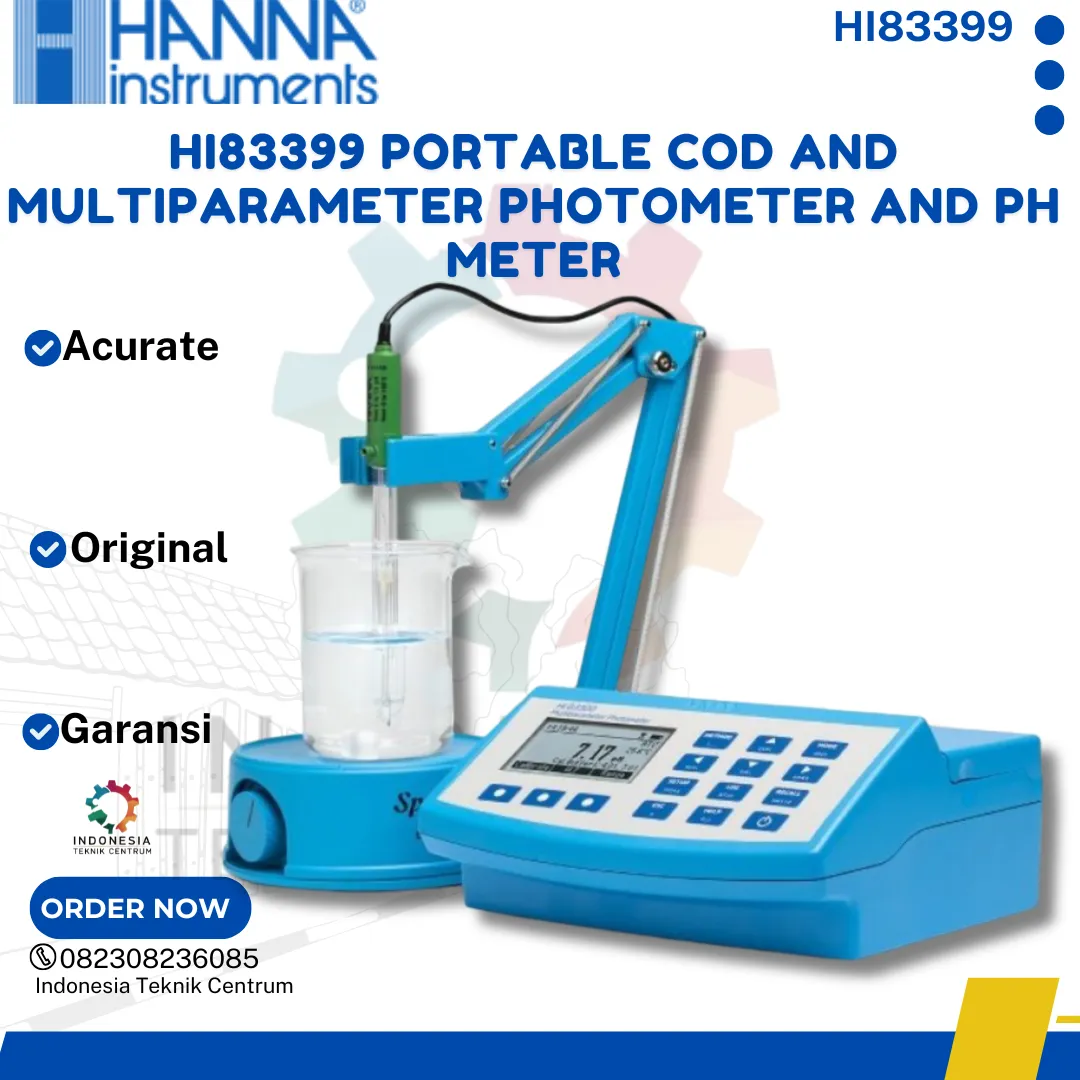
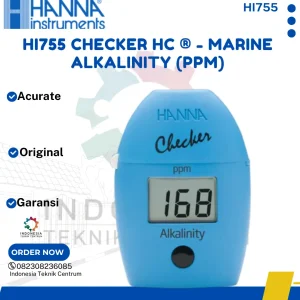
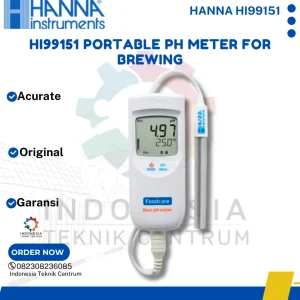
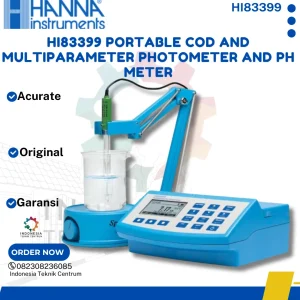
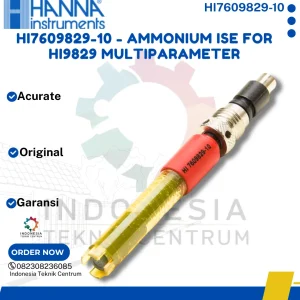
Ulasan
Belum ada ulasan.